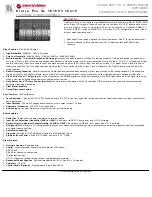
16
Figure 7 Network diagram
Configuration procedure
1.
Set the system operation mode to VXLAN on Switch A, Switch B, and Switch C. This step uses
Switch A as an example.
<SwitchA> system-view
[SwitchA] switch-mode 1
Reboot device to make the configuration take effect.
[SwitchA] quit
<SwitchA> reboot
Start to check configuration with next startup configuration file, please wait..
.......DONE!
Current configuration may be lost after the reboot, save current configuration?
[Y/N]:y
This command will reboot the device. Continue? [Y/N]:y
2.
Configure IP addresses and unicast routing settings:
# Assign IP addresses to interfaces, as shown in
. (Details not shown.)
# Configure OSPF on all transport network switches (Switches A through D). (Details not
shown.)
3.
Configure Switch A:
# Enable L2VPN.
<SwitchA> system-view
[SwitchA] l2vpn enable
# Enable Layer 2 forwarding for VXLANs.
[SwitchA] undo vxlan ip-forwarding
# Create VSI
vpna
and VXLAN 10.
[SwitchA] vsi vpna
[SwitchA-vsi-vpna] vxlan 10
[SwitchA-vsi-vpna-vxlan-10] quit
[SwitchA-vsi-vpna] quit
# Assign an IP address to Loopback 0. The IP address will be used as the source IP address of
the VXLAN tunnels to Switch B and Switch C.
[SwitchA] interface loopback 0
[SwitchA-Loopback0] ip address 1.1.1.1 255.255.255.255
















































